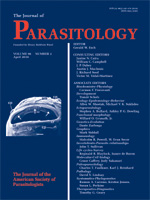Dirofilaria ursi is a filarial nematode of American black bears (Ursus americanus Pallas, 1780) that is vectored by black flies (Simuliidae) in many parts of the United States. In northwestern Wisconsin, the prevalence of microfilaremic bears during the fall hunting season was 21% (n = 47). Unsheathed blood microfilariae from Wisconsin bears possess characters consistent with the original description of D. ursi, as do adult worms observed histologically and grossly. Immunohistochemistry was used to identify the Wolbachia endosymbiont in the hypodermis and lateral cords of an adult female D. ursi. Amplification of wsp, gatB, coxA, fbpA, and ftsZ bacterial sequences from parasite DNA confirmed the presence of Wolbachia, and molecular phylogenetic analysis of the Wolbachia ftsZ gene groups the endosymbiont with Wolbachia from D. immitis and D. repens. Phylogenetic analysis of D. ursi 5s rDNA sequence confirms the morphological observations grouping this parasite as a member of Dirofilaria, and within the Dirofilaria-Onchocerca clade of filarial nematodes. This is the first report of Wolbachia characterization and molecular phylogeny information for D. ursi.
How to translate text using browser tools
1 April 2010
Identification and Phylogenetic Analysis of Dirofilaria ursi (Nematoda: Filarioidea) from Wisconsin Black Bears (Ursus americanus) and its Wolbachia Endosymbiont
Michelle L. Michalski,
Odile Bain,
Kerstin Fischer,
Peter U. Fischer,
Sanjay Kumar,
Jeremy M. Foster





